微信小程序~整合springboot
登录封装
整合微信小程序.我们得先去看微信小程序的文档
我们先来看登录的流程是什么
登录流程时序
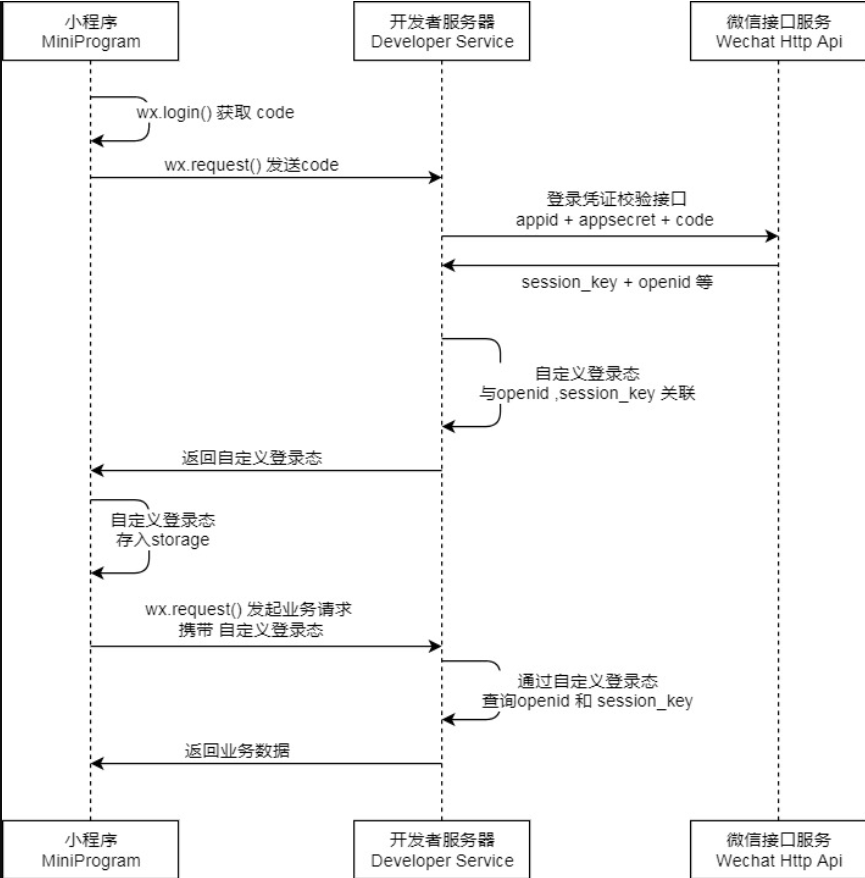
首先,我们小程序要wx.login 获取code,这个code是临时登录凭证code,一次只能用一次
,这个是前端的代码,我这里也就不赘述了,其实很简单的,就是调用这个方法wx.login(),
然后带着这个code发送到我们后端的服务器,再后端服务器中,我们要像微信的接口api发送请求,获得session_id + openid
比较重要的就是这个openid,openid是用户的唯一标识,反而这个session_id不太中重要,因为我们这里用到是token,返回请求之后,我们要生成token返回给前端,前端其他的请求要发过来的化,就要带着这个token
整体的逻辑很简单,前端给到后端,code,后端带着这个code去请求wx的api,返回用户的唯一id,openid,然后,我们得到openid之后,生成token,最后返回给前端
wx 登录api
然后是这里的向微信发送的api的情况


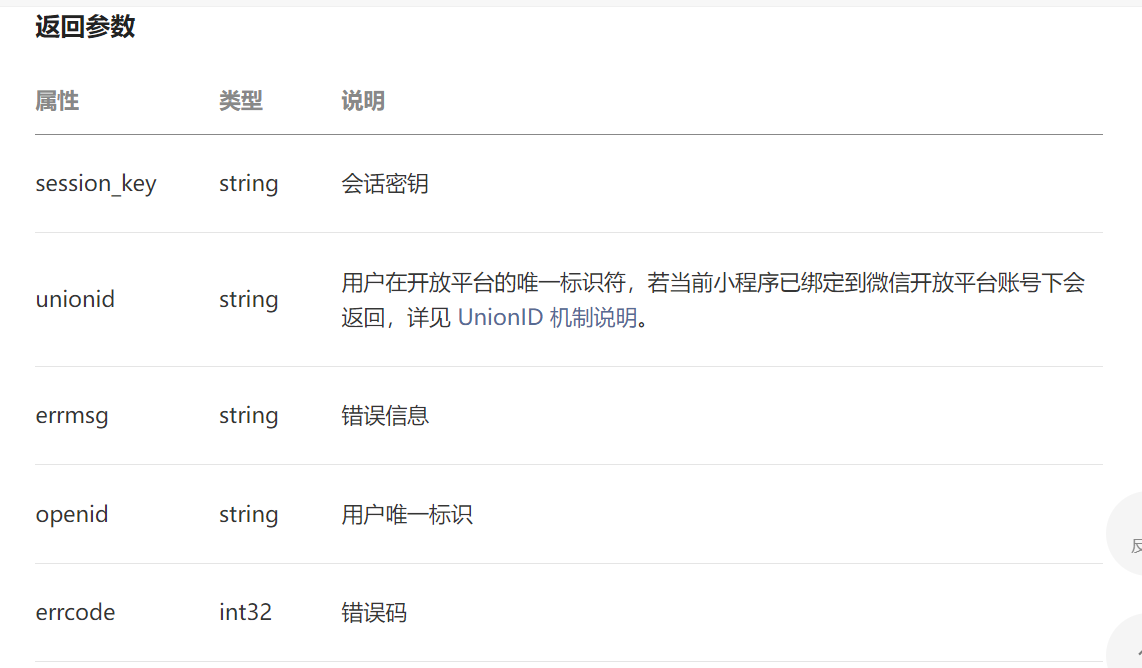
我们来看这里的几个请求参数
我们先来看,已经有的,这里的js_code 就是我们从前端得到的code,;临时登录凭证
然后第四个参数是grant_type是固定参数 authorization_code
然后有两个参数分别是appid,secret这个我们得再小程序里边拿到
位置再如下
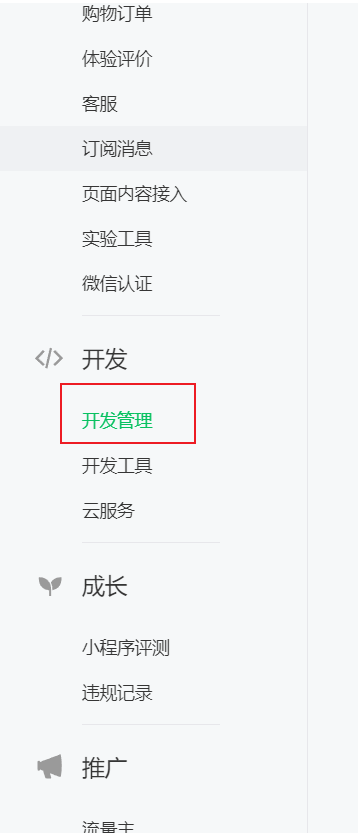
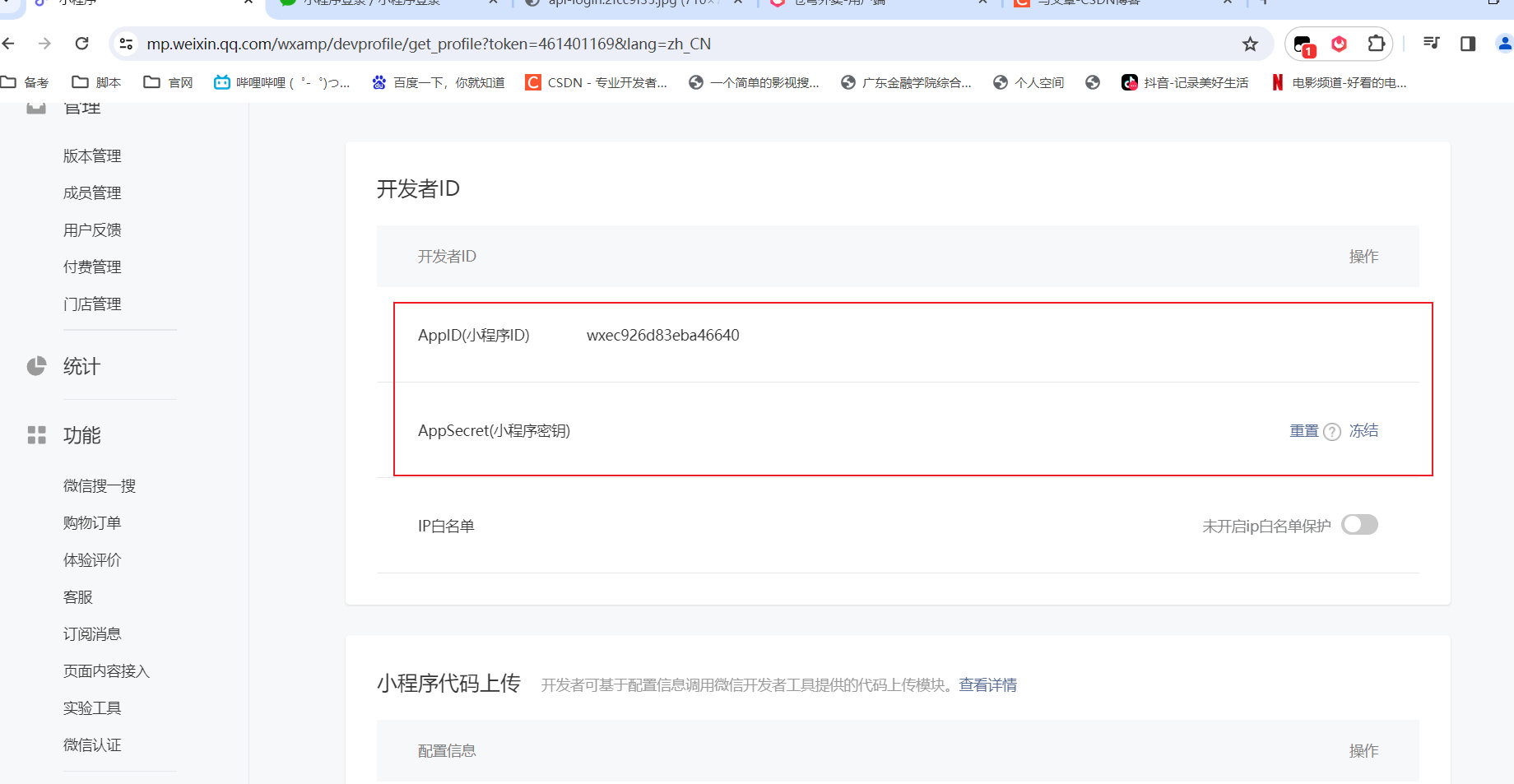
这两个东西都在这里
代码准备工作
httpClient的封装
第一,因为涉及到了要发请求,我们得有发请求的组件,我这里用到的是httpClient,我另外也写了一个httpClient的封装,另外,我另外一个博客也有写,可以去看,我这里就贴出来,httpClient的工具类
/**
* Http工具类
*/
public class HttpClientUtil {
static final int TIMEOUT_MSEC = 5 * 1000;
/**
* 发送GET方式请求
* @param url
* @param paramMap
* @return
*/
public static String doGet(String url,Map<String,String> paramMap){
// 创建Httpclient对象
CloseableHttpClient httpClient = HttpClients.createDefault();
String result = "";
CloseableHttpResponse response = null;
try{
URIBuilder builder = new URIBuilder(url);
//填入参数
if(paramMap != null){
for (String key : paramMap.keySet()) {
builder.addParameter(key,paramMap.get(key));
}
}
URI uri = builder.build();
//创建GET请求
HttpGet httpGet = new HttpGet(uri);
//发送请求
response = httpClient.execute(httpGet);
//判断响应状态
if(response.getStatusLine().getStatusCode() == 200){
result = EntityUtils.toString(response.getEntity(),"UTF-8");
}
}catch (Exception e){
e.printStackTrace();
}finally {
try {
response.close();
httpClient.close();
} catch (IOException e) {
e.printStackTrace();
}
}
return result;
}
/**
* 发送POST方式请求
* @param url
* @param paramMap
* @return
* @throws IOException
*/
public static String doPost(String url, Map<String, String> paramMap) throws IOException {
// 创建Httpclient对象
CloseableHttpClient httpClient = HttpClients.createDefault();
CloseableHttpResponse response = null;
String resultString = "";
try {
// 创建Http Post请求
HttpPost httpPost = new HttpPost(url);
// 创建参数列表
if (paramMap != null) {
List<NameValuePair> paramList = new ArrayList();
for (Map.Entry<String, String> param : paramMap.entrySet()) {
paramList.add(new BasicNameValuePair(param.getKey(), param.getValue()));
}
// 模拟表单
UrlEncodedFormEntity entity = new UrlEncodedFormEntity(paramList);
httpPost.setEntity(entity);
}
httpPost.setConfig(builderRequestConfig());
// 执行http请求
response = httpClient.execute(httpPost);
resultString = EntityUtils.toString(response.getEntity(), "UTF-8");
} catch (Exception e) {
throw e;
} finally {
try {
response.close();
} catch (IOException e) {
e.printStackTrace();
}
}
return resultString;
}
/**
* 发送POST方式请求
* @param url
* @param paramMap
* @return
* @throws IOException
*/
public static String doPost4Json(String url, Map<String, String> paramMap) throws IOException {
// 创建Httpclient对象
CloseableHttpClient httpClient = HttpClients.createDefault();
CloseableHttpResponse response = null;
String resultString = "";
try {
// 创建Http Post请求
HttpPost httpPost = new HttpPost(url);
if (paramMap != null) {
//构造json格式数据
JSONObject jsonObject = new JSONObject();
for (Map.Entry<String, String> param : paramMap.entrySet()) {
jsonObject.put(param.getKey(),param.getValue());
}
StringEntity entity = new StringEntity(jsonObject.toString(),"utf-8");
//设置请求编码
entity.setContentEncoding("utf-8");
//设置数据类型
entity.setContentType("application/json");
httpPost.setEntity(entity);
}
httpPost.setConfig(builderRequestConfig());
// 执行http请求
response = httpClient.execute(httpPost);
resultString = EntityUtils.toString(response.getEntity(), "UTF-8");
} catch (Exception e) {
throw e;
} finally {
try {
response.close();
} catch (IOException e) {
e.printStackTrace();
}
}
return resultString;
}
private static RequestConfig builderRequestConfig() {
return RequestConfig.custom()
.setConnectTimeout(TIMEOUT_MSEC)
.setConnectionRequestTimeout(TIMEOUT_MSEC)
.setSocketTimeout(TIMEOUT_MSEC).build();
}
}
属性的设置
首先是微信相关的属性的设置
@Component
@ConfigurationProperties(prefix = "sky.wechat")
@Data
public class WeChatProperties {
private String appid; //小程序的appid
private String secret; //小程序的秘钥
private String mchid; //商户号
private String mchSerialNo; //商户API证书的证书序列号
private String privateKeyFilePath; //商户私钥文件
private String apiV3Key; //证书解密的密钥
private String weChatPayCertFilePath; //平台证书
private String notifyUrl; //支付成功的回调地址
private String refundNotifyUrl; //退款成功的回调地址
}
然后是这里的jwt token相关的属性,我这里因为是后端和小程序端是分开的,所以我这里也得写
@Component
@ConfigurationProperties(prefix = "sky.jwt")
@Data
public class JwtProperties {
/**
* 管理端员工生成jwt令牌相关配置
*/
private String adminSecretKey;
private long adminTtl;
private String adminTokenName;
/**
* 用户端微信用户生成jwt令牌相关配置
*/
private String userSecretKey;
private long userTtl;
private String userTokenName;
}
分别在yml中进行设置
sky:
jwt:
user-secret-key: itheima
user-ttl: 7200000
user-token-name: authentication
wechat:
appid: ${sky.wechat.appid}
secret: ${sky.wechat.secret}
我这里做了一个解耦,这里是主yml,真正的配置我写到了dev.yml中
sky:
wechat:
appid: 自己的appid
secret: 自己的密码
这里就差不多准备工作做完了
核心代码
/**
* @author jjking
* @date 2024-01-25 21:10
*/
@RestController
@RequestMapping("/user/user")
@Slf4j
@Api(tags = "用户相关")
public class UserController {
@Autowired
private UserService userService;
@Autowired
private JwtProperties jwtProperties;
/**
* 微信登录
* @param userLoginDTO
* @return
*/
@PostMapping("/login")
@ApiOperation("微信登录")
public Result<UserLoginVO> login(@RequestBody UserLoginDTO userLoginDTO) {
log.info("微信用户登录: {}",userLoginDTO.getCode());
//获得用户信息
User user = userService.wxLogin(userLoginDTO);
//生成jwt令牌
Map<String, Object> claims = new HashMap<>();
claims.put(JwtClaimsConstant.USER_ID,user.getId());
String token = JwtUtil.createJWT(jwtProperties.getUserSecretKey(), jwtProperties.getUserTtl(), claims);
UserLoginVO userLoginVO = UserLoginVO.builder()
.id(user.getId())
.openid(user.getOpenid())
.token(token)
.build();
return Result.success(userLoginVO);
}
}
这里真正的核心代码在userService.wxLogin(userLoginDTO);里边,我们这里外边就是获得openid,然后生成jwt token
这里的jwt Util这里我也贴出来
public class JwtUtil {
/**
* 生成jwt
* 使用Hs256算法, 私匙使用固定秘钥
*
* @param secretKey jwt秘钥
* @param ttlMillis jwt过期时间(毫秒)
* @param claims 设置的信息
* @return
*/
public static String createJWT(String secretKey, long ttlMillis, Map<String, Object> claims) {
// 指定签名的时候使用的签名算法,也就是header那部分
SignatureAlgorithm signatureAlgorithm = SignatureAlgorithm.HS256;
// 生成JWT的时间
long expMillis = System.currentTimeMillis() + ttlMillis;
Date exp = new Date(expMillis);
// 设置jwt的body
JwtBuilder builder = Jwts.builder()
// 如果有私有声明,一定要先设置这个自己创建的私有的声明,这个是给builder的claim赋值,一旦写在标准的声明赋值之后,就是覆盖了那些标准的声明的
.setClaims(claims)
// 设置签名使用的签名算法和签名使用的秘钥
.signWith(signatureAlgorithm, secretKey.getBytes(StandardCharsets.UTF_8))
// 设置过期时间
.setExpiration(exp);
return builder.compact();
}
/**
* Token解密
*
* @param secretKey jwt秘钥 此秘钥一定要保留好在服务端, 不能暴露出去, 否则sign就可以被伪造, 如果对接多个客户端建议改造成多个
* @param token 加密后的token
* @return
*/
public static Claims parseJWT(String secretKey, String token) {
// 得到DefaultJwtParser
Claims claims = Jwts.parser()
// 设置签名的秘钥
.setSigningKey(secretKey.getBytes(StandardCharsets.UTF_8))
// 设置需要解析的jwt
.parseClaimsJws(token).getBody();
return claims;
}
}
最核心的代码
我门在service中的写的这个方法就是最核心的代码
/**
* 用户信息(User)表服务实现类
*
* @author makejava
* @since 2024-01-25 21:06:35
*/
@Service("userService")
public class UserServiceImpl extends ServiceImpl<UserMapper, User> implements UserService {
@Override
public User wxLogin(UserLoginDTO userLoginDTO) {
String openid = getOpenId(userLoginDTO.getCode());
//如果返回的是空,说明没有这个用固话,表示登录失败,抛出业务异常
if(StrUtil.isBlankOrUndefined(openid)) {
//返回登录失败
throw new LoginFailedException(MessageConstant.LOGIN_FAILED);
}
//查数据库,中是否有这个用户
LambdaQueryWrapper<User> wrapper = new LambdaQueryWrapper<>();
wrapper.eq(User::getOpenid,openid);
User user = getOne(wrapper);
//如果当前用户是新用户,那么就要存入进入
if(Objects.isNull(user)) {
user = User.builder().openid(openid).build();
save(user);
}
//如果不是直接返回
return user;
}
//wx登录api
public static final String WX_LOGIN = "https://api.weixin.qq.com/sns/jscode2session";
@Autowired
private WeChatProperties weChatProperties;
public String getOpenId(String code) {
Map<String, String> paramMap = new HashMap<>();
paramMap.put("appid",weChatProperties.getAppid());
paramMap.put("secret",weChatProperties.getSecret());
paramMap.put("js_code",code);
paramMap.put("grant_type","authorization_code");
//发送请求
String json = HttpClientUtil.doGet(WX_LOGIN, paramMap);
//解码json数据
JSONObject jsonObject = JSON.parseObject(json);
String openid = jsonObject.getString("openid");
return openid;
}
}
拦截器设置
/**
* jwt令牌校验的拦截器
*/
@Component
@Slf4j
public class JwtTokenUserInterceptor implements HandlerInterceptor {
@Autowired
private JwtProperties jwtProperties;
/**
* 校验jwt
*
* @param request
* @param response
* @param handler
* @return
* @throws Exception
*/
public boolean preHandle(HttpServletRequest request, HttpServletResponse response, Object handler) throws Exception {
//判断当前拦截到的是Controller的方法还是其他资源
if (!(handler instanceof HandlerMethod)) {
//当前拦截到的不是动态方法,直接放行
return true;
}
//1、从请求头中获取令牌
String token = request.getHeader(jwtProperties.getUserTokenName());
//2、校验令牌
try {
log.info("jwt校验:{}", token);
Claims claims = JwtUtil.parseJWT(jwtProperties.getUserSecretKey(), token);
Long userId = Long.valueOf(claims.get(JwtClaimsConstant.USER_ID).toString());
log.info("当前用户id:", userId);
//设置当前用户id,到ThreadLocal中
BaseContext.setCurrentId(userId);
//3、通过,放行
return true;
} catch (Exception ex) {
//4、不通过,响应401状态码
response.setStatus(401);
return false;
}
}
}
我们一定得写这个拦截器,要实现校验jwt的功能,
写了这个配置类,我们还得把它写道mvc的配置里边
/**
* 注册自定义拦截器
*
* @param registry
*/
protected void addInterceptors(InterceptorRegistry registry) {
log.info("开始注册自定义拦截器...");
//添加后端蓝机器
registry.addInterceptor(jwtTokenAdminInterceptor)
.addPathPatterns("/admin/**")
.excludePathPatterns("/admin/employee/login");
//添加用户拦截器
registry.addInterceptor(jwtTokenUserInterceptor)
.addPathPatterns("/user/**")
.excludePathPatterns("/user/user/login")
.excludePathPatterns("/user/shop/status");
}
这里的代码就是我刚刚说的流程差不多
测试
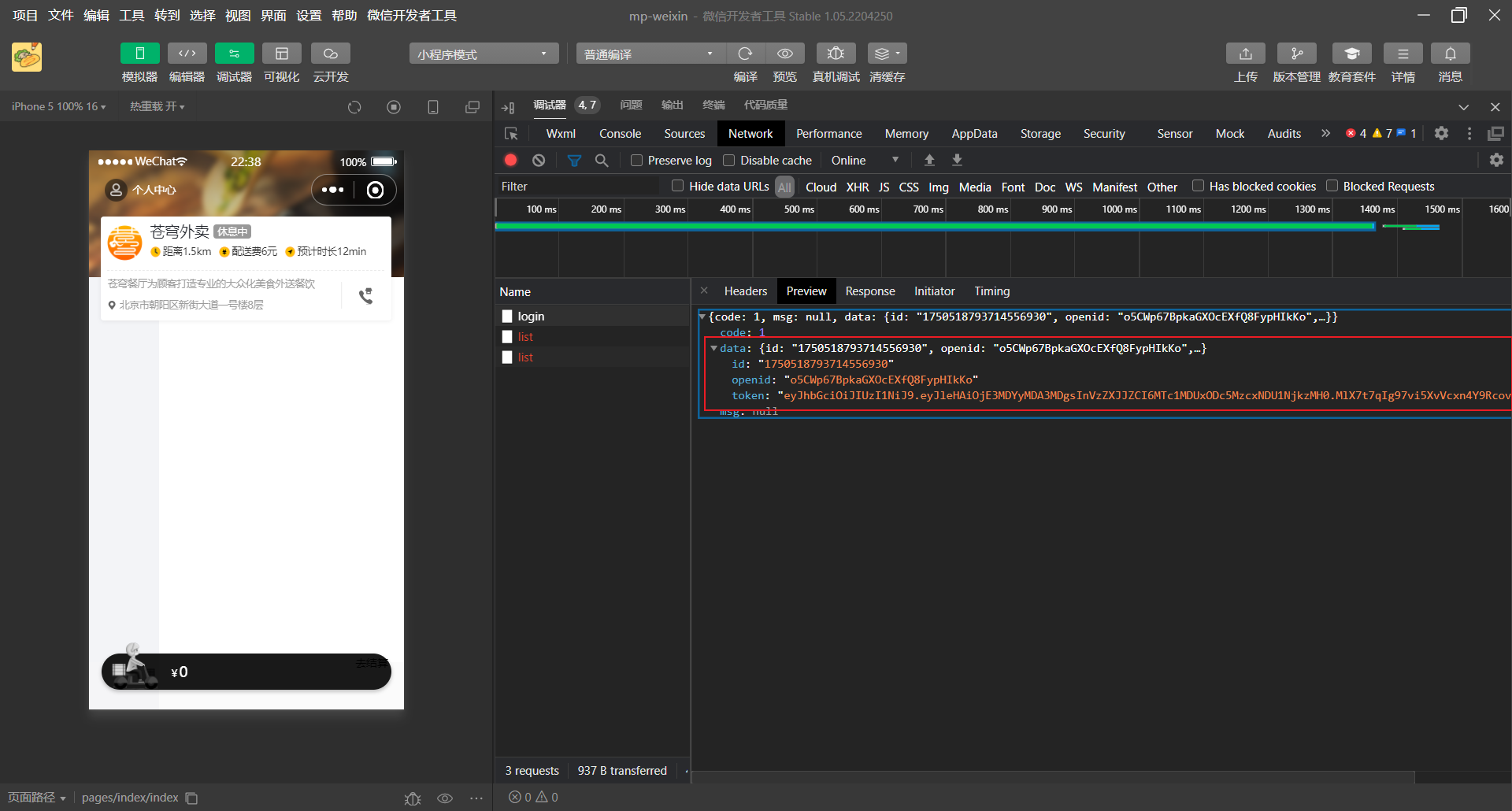
最后我们能得到token就没问题























 1946
1946











 被折叠的 条评论
为什么被折叠?
被折叠的 条评论
为什么被折叠?










